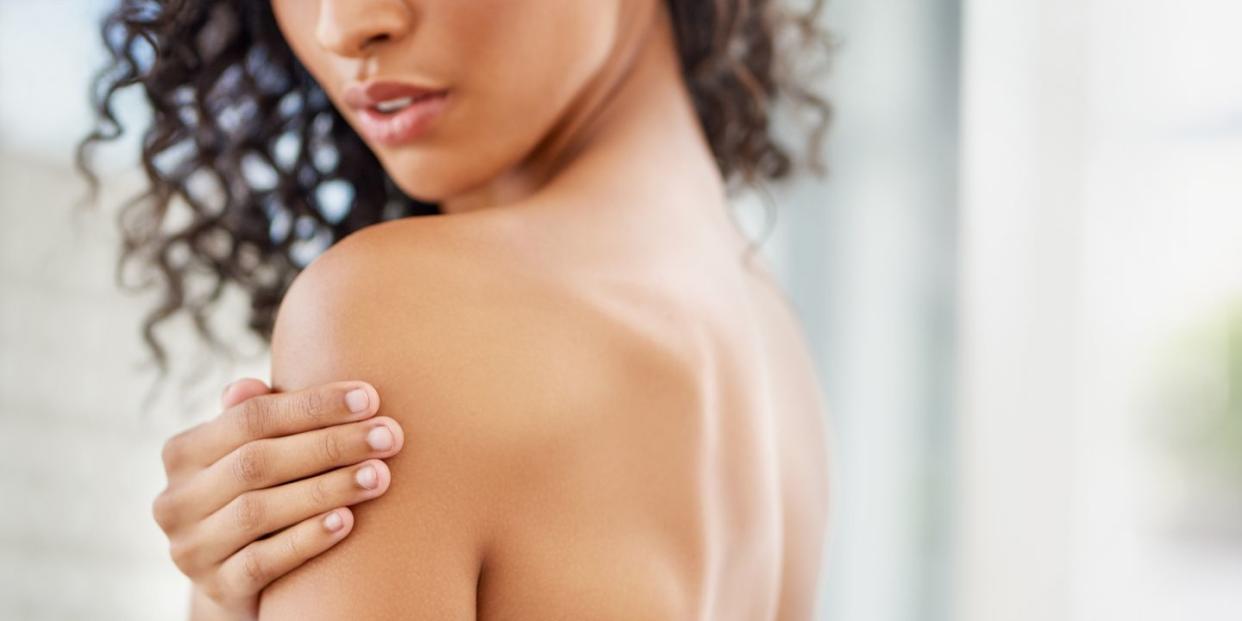You Should Actually Be Washing and Exfoliating Your Back on the Regular

While back acne (a.k.a bacne) is totally normal, it may still leave you feeling insecure from time to time — and that's also normal. "Bacne is a frustrating and often embarrassing condition, and it can even cause people to avoid wearing open-back clothing and avoid participating in certain activities," says Stacy Chimento, MD, board-certified dermatologist at Riverchase Dermatology in Florida.
Back acne commonly arises when excess sebum, bacteria and dead skin cells build up in pores, causing redness, inflammation and blemishes — similar to facial acne, except on your back. It can also be triggered by hormonal changes, which is why teenagers are often plagued with it, and why you may notice it pop up around your period or pregnancy; and daily habits like diet and clothing choices may also play a role.
Luckily, a few simple modifications to your daily routine can help you make those body pimples a thing of the past.
Here are a few tips on how to get rid of back acne:
Change your sheets
Try your best to change your sheets about once a week or so. "Changing your sheets frequently is beneficial because dead skin cells and bacteria can easily accumulate on them throughout the night and irritate skin," says Dr. Chimento.
Make over your morning routine
Your conditioner, your sunscreen (especially if you have sensitive skin), your body cream — can all clog pores, causing you to get zits on your back. Luckily, a few easy tweaks to your get-ready routine can help slash your chances of one popping up.
When washing and conditioning, flip your hair to the front and rinse forward to avoid leaving shampoo and conditioner residue on your back — and rinse your whole body thoroughly before stepping out of the shower. In summertime, it's better to use lotions rather than creams because they have less oil content and rely more on water to hydrate the skin, so they're less clogging. "Only use non-comedogenic creams and lotions: these products are specifically formulated with ingredients that won't block pores," Dr. Chimento says.
And when it's time to apply sunscreen, choose one that is labeled "ultra-light" or "quick-dry" like La Roche Posay Anthelios 60 Ultra Light Sunscreen Fluid.
Swap out your clothing
Certain types of clothing can trigger a breakout — and your workout clothes (plus the act of exercising) is a particularly perfect recipe. That's because tight clothing can push oils or bacteria deeper into pores, and the friction from tight-fitting workout clothes like sports bras or leggings can further irritate hair follicles and cause red bumps. If you can, reach for breathable materials like cotton or moisture-wicking items. If you can't change over your entire wardrobe, be sure to always shower after sweating. "After workouts or a sweaty activity you must shower," says Tami Cassis M.D., assistant clinical professor of dermatology at The University of Louisville. "Running around afterward in sports bras or gym shirts is a big no-no."
Choose the right cleanser
If pimply skin runs in your family, don't be surprised if you get it, too — despite your best efforts to keep it at bay. But don't worry, there are ways to get around your genes. Try using an over-the-counter salicylic acid or glycolic acid wash to prevent and cure blemishes — is a good pick. Washes have a tendency to be less irritating than leave-on medications, and because they are usually incorporated into your shower routine, they are more readily available, and therefore more regularly used. If these don't cut it, a prescription-strength topical medication or oral antibiotic may be recommended by your derm.
Eat skin-friendly foods
It may be time to up your produce game, because fruits and vegetables are packed with an array of vitamins and other anti-inflammatory nutrients that are super good for your skin. Eat a well-balanced diet — any extreme or restrictive eating plan is not healthy for your overall body, so just consider cutting back on foods that may up your risk of developing acne, such as dairy and refined carbohydrates like sugar and white flour, rather than eliminating them all together. "Poor diets can cause blood sugar to increase, which leads to inflammation, and in turn, acne," Dr. Chimento says. And don't forget to drink plenty of water—staying hydrated also helps keep your skin healthy and acne at bay.
Give your back extra love
This may seem like a no brainer, but forgetting to wash or exfoliate your back is more common than you think, but it's one of the most acne-prone areas, so you need to give it just as much attention as you do your facial skin. Regularly clean and exfoliate your back to help keep the follicles clean and unclogged, making them less prone to pimples. Try a gentle exfoliating cleanser such as Dove Gentle Exfoliating Body Wash, which helps to cleanse, hydrate, exfoliate and even calm inflamed skin. "An antibacterial cleanser may also help," says Dr. Chimento. People are also starting to treat acne with light devices, which can be great, effective alternatives to traditional treatments; talk to a dermatologist about which product or in-office treatment might be right for you.
See a dermatologist
If you've tried all of the above and your bacne is still stubbornly sticking around, consider scheduling a consultation with a dermatologist. They may be able to offer personalized advice to keep things under control or suggest oral or topical prescription medications that may just do the trick.
You Might Also Like


